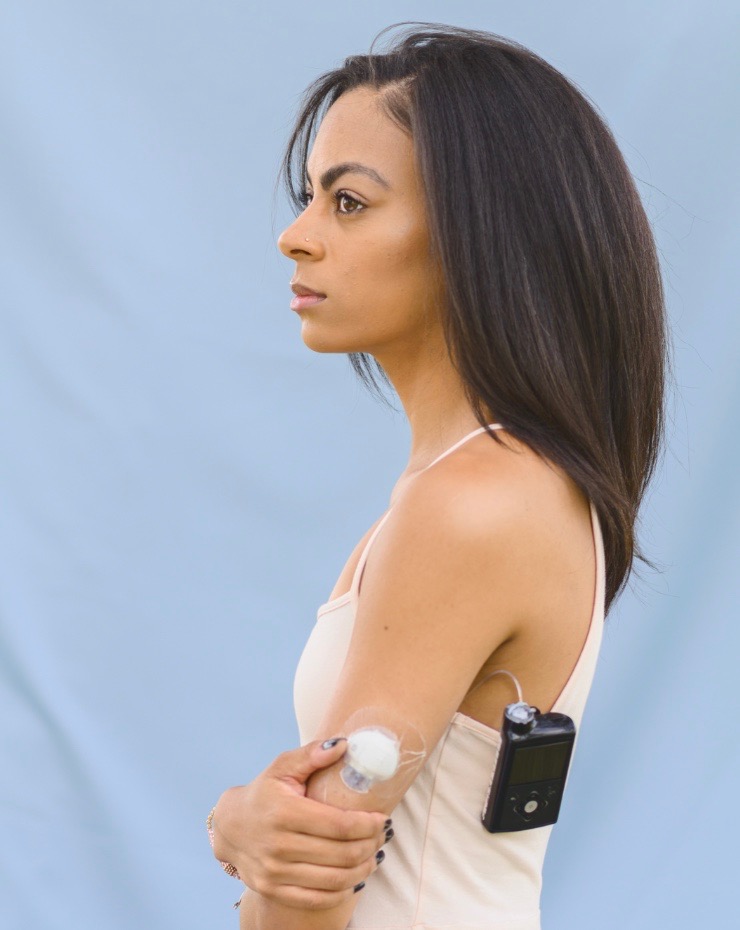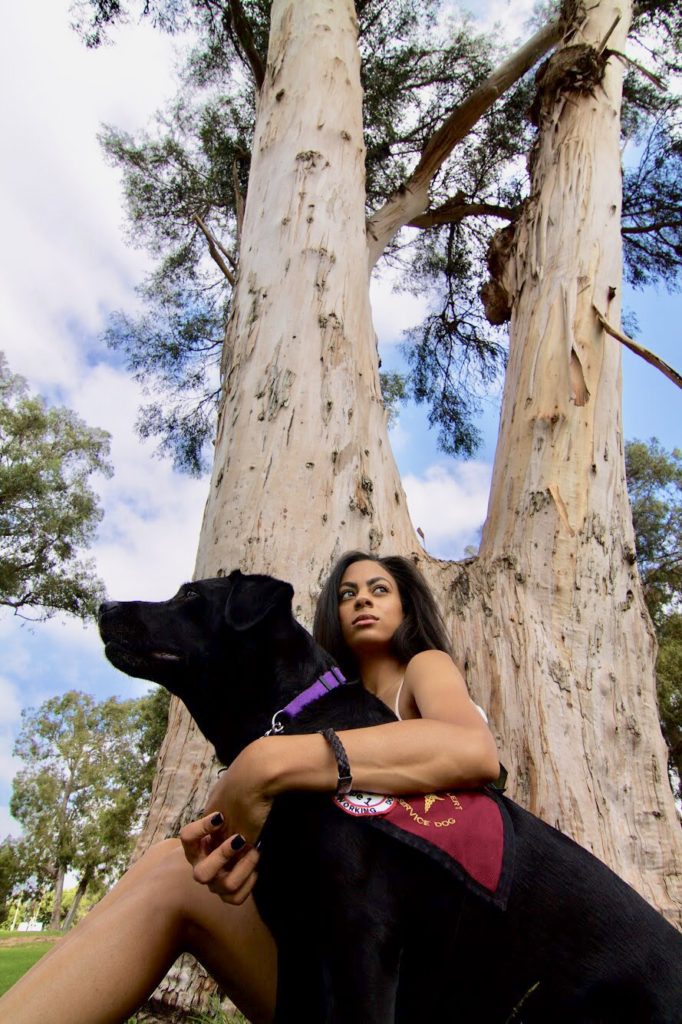Diabetic on the Margin: Monique
Monique reached out to me almost a year ago asking to share her journey with her Diabetic Alert Dog, Waimea. In her message to me, she stated, “I never realized before…how little our culture knows about service animals.” She continued, “I know I can’t be the only black person with a service animal,” Since then, Monique has made it her mission to spread awareness, find others like her and let folks know that it’s okay to be different. This is part of her story, in her own words.

Generally I get a side-eye or rude comment at least 10 times a day. I am 25 years old and from first glance look perfectly healthy. Even with an insulin pump on my hip and a glucose sensor in my arm, it’s pretty hard to see that I battle a chronic condition daily. Most people assume I traveled back in time and returned with a pager or that I’m wearing a pacemaker. That was, until I received my Medical Alert Service Dog in August 2016. Now I have a four-legged shadow named Waimea. Waimea was originally bred to be a seeing eye dog, but due to medical and possibly some behavioral issues, she was given a “career change” and became a Diabetic Alert Dog (D.A.D.) instead.
I was diagnosed with Type 1 Diabetes at the age of 13/14, just a few weeks after beginning high school. I didn’t eat or do the wrong things growing up. My body attacked itself and now I have an organ that doesn’t fully function. No matter how hard my doctors and I worked, we could not get control over my blood glucose levels, and so I began searching for the right company to pair me with a D.A.D. It took me roughly five years I applied to numerous companies and paid multiple application fees with no luck. In my last year of college I met a fellow student with a D.A.D. He told me of the company he used and how to go about the process. A year later I met Waimea at an orientation in Concord, CA. Out of all the dogs and families present, I felt Waimea would be paired with me.

I knew having a service dog would be a challenge. I could no longer hide. It would be present everywhere I went. For the most part, my encounters with strangers involve curiosity. Generally, people assume I am training her and I simply educate them on how she saves my life daily. This tends to end with them being thankful for learning something new and wishing me the best. Still, there are the people who look me up and down trying to find the correct disability to label me with. They tend to whisper and point. Most shake their heads or turn up their nose assuming she is a therapy or emotional support dog. These dogs do amazing work for the humans that need them. However, therapy dogs are not public access service dogs. They are not allowed in the general public. These dogs do not have to be trained and do not perform a specific task other than emotional support. Some people abuse this label and use it as a reason to bring their dog to stores giving service animals a bad name. These dogs generally bark at other people and are sitting in a basket or in a purse. I believe this plays a huge role in the thought that I must be in a wheelchair or blind to have a legitimate service animal.
I think another major part of the problem is lack of knowledge regarding service animals and the type of services they provide. On, April 28th, 2018, I experienced something that seemed to justify one of my beliefs:
A family walks by me as I’m waiting to be seated at a restaurant. The mother is explaining to her toddlers that Waimea is a working dog and cannot be distracted therefore they cannot say hello to her. The oldest child assumes this means she must ask for my permission (true for the most part). I explain to the mother that I am okay with her children saying hello, as long as it is okay with her. I did not want to interfere with her teaching moment. The children begin petting and playing with Waimea. As I am speaking with the mother I feel a hand come from behind me and watch as it begins to pet my dog as well. I turn my head and the woman who has approached is now half an inch from my face staring into my eyes. “Are you blind?” she sarcastically asks. I explain that I am not. She then asks what Waimea is for? I respond that she is a medical alert dog. The woman inquires if Waimea can detect an illness in strangers. I explain that I am not training her and I am the one with an illness that can be fatal. Laughing, the woman asks if it’s “dizzy spells”? At this point I am failing to keep calm and still trying to be nice to the family that is petting Waimea. The mother of the family can see I am struggling to be respectful as my privacy is being invaded. I explain that my illness is not something I wish to discuss with a stranger, however my tone shows more than I intended. Eventually the lady picks up on my social cues and walks away after trying to apologize.

These incidents happen quite often, at least once a week. People tend to assume one of three things. I am training Waimea, I am faking my disability, or that they have the right to cause a distraction and pet Waimea at their will. I have been whistled at and barked at. I have had people stand at the end of a store aisle to prevent me from leaving so they can take photos. There have been loud whispers from neighboring tables in restaurants asking why there’s a dog present. I have had men tell me I don’t look blind and after a little education, then ask me for my phone number as if their initial greeting was not an insult. I’ve been chased around a store by a woman and her screaming toddler. The list goes on and on. As a result, my family members have become unofficial bodyguards and we’ve termed the peeping eyes, “pup-arazzi”.
Many of the people I encounter look at Waimea and I, and refuse to respect our partnership. They argue that they have a right to say hello. They block my path as I’m walking or decide that the idea of being sued for putting my life in danger is beneath them. People are generally confused and disgusted seeing an animal under a dining table. When you think about your home, where is your pet when you’re having dinner? The difference here is Waimea stays on the floor silent and invisible. She is held to the highest grooming standards one can imagine. I believe lack of knowledge and exposure to service animals is the main cause of this poor treatment. The majority of us have only seen service animals in movies and on television.
As a child it was hard to find support groups and communities of people living with Type 1 Diabetes. Most of the support groups and organizations tend to cater to a specific demographic. Following Beyond Type 1, was the first time I saw a diverse group of individuals fighting the same battle. I now follow numerous individuals with T1D and even have a diabetic pen pal in India. After being paired with Waimea I began following blogs and social media accounts of individuals with service animals. Whether their dog is for Type 1 Diabetes or another medical condition, I’ve noticed similar troubles–people refusing to understand or be respectful, etc. I want to spread awareness about service animals, regardless of what they are trained to do. I want people to understand the difference between an emotional support animal and a Medical Alert service animal. I think the world needs to understand that these amazing animals can be trained to detect and assist with all sorts of medical conditions. Guiding the blind, assisting those with limited mobility, detecting severe high and low blood sugars, preventing seizures, aiding those with PTSD. This is only the tip of the iceberg. Dogs are truly gifts from God and anyone who owns one knows their love is unconditional.

For me, Waimea is able to detect my blood sugars rising or falling and alert me almost 20 minutes before my continuous glucose monitor. Just by using her nose she has prevented comas and DKA. Some people assume service animals are sad and should not be forced to work. Waimea is one of the happiest dogs you will ever meet. She is a diva and is very good at rolling her eyes or giving you “puppy eyes” to get her way. She loves to play and loves to meet new people. She loves to run and has a best friend named Ricki, another D.A.D. She adores squeaky toys and kids almost more than she does other dogs. She will force you to love her and give her attention. She enjoys her job and is rewarded for every alert. Her belly is always full and she sees a vet almost as much as I see an endocrinologist. She is very well taken care of.
Caring for a living breathing animal is not easy. Taking a dog with you to work or to run your daily errands can be a hassle. Some people are judgmental and mean. In fact, I lost my very first job about 6 months after bringing Waimea home. It takes hard work and tough skin to have a service dog, but the results are indescribable. I am able to sleep at night knowing that if my blood glucose drops and my sensor malfunctions, Waimea will wake me up. There’s also a sense of security and independence I’ve obtained. Even with all the terrible and frustrating interactions I’ve had because of her, I wouldn’t change a thing.
I have met so many people since having Waimea, including parents of a child recently diagnosed with type 1, people who have T1D, or those who know someone with the disease. I have truly enjoyed explaining to them the benefits of having this guardian angel. I decided very early that I would spread awareness about my condition. I would correct negative stereotypes and fight to get people to understand. Now, I want to show people that service animals can aid in all sorts of medical conditions. Those of us with legitimate service animals are not forcing our dogs to work. We aren’t using our illness to get special treatment. We are striving to be independent, safe, and live our lives as normally as possible. My goal is to simply educate, to possibly end the negative stigma related to service animals and to make life a little easier for those of us already paired with an angel. I want people from all walks of life to understand that this is an option.
You may follow Monique on Instagram at: @moniquenicolee


What a great read.
I have thought about getting an alert dog myself.
Hi Ariel, thanks for sharing Monique’s story. I’ve been for a while now thinking about having an alert dog myself (not possible right now, though). As previous mentioned I found that people think that alert dogs are for blind or visually impaired people only!